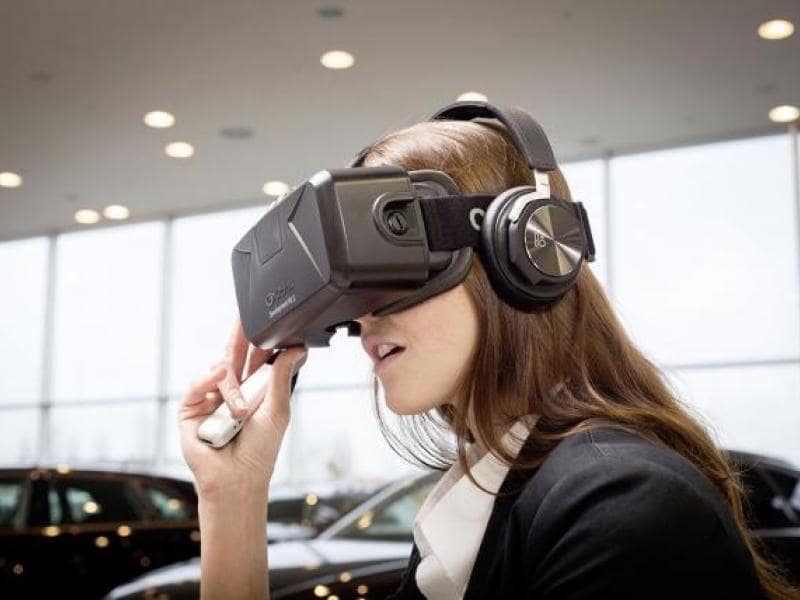Virtual reality in marketing strategy
Is virtual reality better for presenting products and services? See how brands use virtual and augmented reality technologies in their marketing strategies.
A third of global consumers are expected to benefit from the opportunities offered by virtual and augmented reality. More and more affordable devices will appear on the market, making content available to the mass market as well. Some companies are already realizing that it is worth taking this technology into account in their marketing strategy. See what possibilities are offered by marketing activities using virtual reality.
Virtual reality and augmented reality
Virtual Reality means technologies that generate a fully artificial environment. It consists of image, sound, and sometimes even touch or smell. The displayed image allows for its reception in a way similar to the behaviour of our eyes, so that the recipient can fully immerse himself in the created world.
Augmented Reality, in turn, connects the real world with the virtual world, and the created image is superimposed on the real world. While in this case the elements are static, the so-called mixed reality (combining virtual and augmented reality) is already highly interactive with the user.
Examples of using virtual reality in marketing activities
Virtual reality was initially associated with the computer game industry. Thanks to the fact that a player can fully find himself in the virtual reality, it is possible to provide players with a greater experience. With time, it began to gain popularity also in other industries, such as medicine and the automotive industry.
Today, regardless of the industry, virtual reality is increasingly used by brands in their marketing activities. It’s no wonder that artificial reality can affect practically every sense, so it can reach the recipient more intensively.
Explore the product from all sides
Although the unquestionable advantage of online shops is the possibility to do shopping without leaving home, sometimes the obstacle turns out to be the inability to see the goods carefully before buying. Thanks to 360-degree films it is possible to present things in their full size, precisely define the visual features and parameters and check the functionality personally by the consumer. This solution is used, among others, by the eBay platform, which wants virtual shopping to be simple and, above all, comfortable for their customers.
See your future home
During the presentation of an apartment, developers can take advantage of the fact that virtual reality allows clients to take a virtual walk around the property still under construction and arrange it in their own way. By using artificial reality, we can check whether the new armchair will go well with our current sofa and whether there is enough space between the table and the window for a cupboard.
Experience the pleasure of travelling
Artificial reality also allows us to move to an authentic place really far away from us, even thousands of kilometres. This is what the Marriott hotel chain used in its campaign for the newlyweds, who, after wearing glasses, moved to the ideal honeymoon locations scattered around the world. Apart from exotic landscapes, the participants could also visit the interior of the chain’s hotel located there.
Try out a new car model
Using virtual reality technology, we can experience a test drive or feel what it’s like to be the driver of the fastest car in the world. Volvo used this to promote the new Volvo XC90, where everyone could enjoy a test drive of the new model after downloading the application.
Explore the product history
Through virtual reality we can learn more about the process of creating a given product or service. Customers pay more and more attention to openness in the activities of companies, and the confidence aroused facilitates their purchasing decision. Toms Shoes is known for the fact that with every pair of shoes sold, one pair to those in need. As part of the ‘A walk in their shoes’ campaign, they wanted to share with their customers the feelings they experience in these activities.

Benefits of using virtual reality
Virtual reality brings many benefits both for the brand and for its recipients, among others:
- It gives the opportunity to present an absent product – even in the case of a physical lack of a product, it can be presented in an innovative and non-standard way, bringing the customer closer to its visual features and parameters.
- Ensure maximum immersion – with the help of artificial reality, consumers can completely immerse themselves in the virtual world experiencing a positive experience. This allows the creation of positive emotions connected with the product even before its purchase;
- Enables barrier-free marketing – distance is irrelevant when establishing contact with a potential customer, because the entire process of presenting a product or service takes place in a digitally produced world.
- It gives the opportunity to get valuable suggestions from the recipients – it is possible to get feedback from consumers even before the actual product or service is launched on the market.
- Increases the reach of the customer segment – the use of artificial reality is still of great interest to consumers, who are always open to new experiences. It also makes it easier to find innovative activities that attract attention and have a wide echo.
Is virtual reality the better place to present products and services?
Conducting activities in virtual reality gives marketers new and greater opportunities. Not only does it make it easier to reach more consumers, but it also allows for a greater variety of activities that can have a stronger impact on the emotions and perception of a product or service.
Marketing activities in an artificial reality are not intended to replace those existing. Rather than displacing traditional marketing activities, they should be seen as an additional platform for creative ideas. Virtual reality technologies are a perfect addition to brand marketing strategy.

